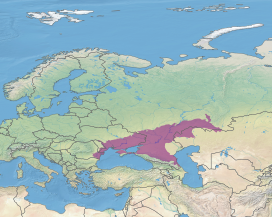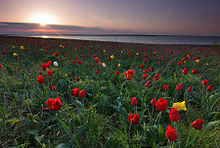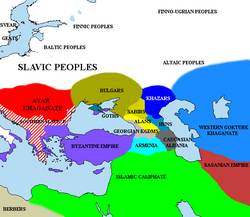Pontic–Caspian steppe
| Pontic–Caspian steppe | |
|---|---|
 The steppe in Azov-Syvash National Nature Park, Ukraine, with reintroduced horses. | |
 The steppe extends roughly from the Danube to the Ural River | |
| Ecology | |
| Realm | Palearctic |
| Biome | temperate grasslands, savannas, and shrublands |
| Borders | show
List |
| Geography | |
| Area | 994,000 km2 (384,000 sq mi) |
| Countries | show
List |


The Pontic–Caspian steppe (sometimes called the "Caspian steppe" or "Pontic steppe") is the steppeland stretching from the northern shores of the Black Sea (the Pontus Euxinus of antiquity) to the northern area around the Caspian Sea. It extends from Dobruja in the northeastern corner of Bulgaria and southeastern Romania, through Moldova and southern and eastern Ukraine, across the Russian Northern Caucasus, the Southern and lower Volga regions to western Kazakhstan, adjacent to the Kazakh steppe to the east, both forming part of the larger Eurasian Steppe. It forms a part of the Palearctic realm and of the temperate grasslands, savannas, and shrublands biome.
The area corresponds to Cimmeria, Scythia, and Sarmatia of classical antiquity. Across several millennia, numerous tribes of nomadic horsemen used the steppe; many of them went on to conquer lands in the settled regions of Europe, Western Asia, and Southern Asia.
The term Ponto-Caspian region is used in biogeography with reference to the flora and fauna of these steppes, including animals from the Black Sea, Caspian Sea, and Azov Sea. It used to be thought that this region was the first to domesticate horses, but recent studies have concluded that domestication of horses actually occurred in the far east of Kazakhstan, near Mongolia and Siberia.[1]
According to the most prevalent theory in Indo-European studies, the Kurgan hypothesis, the Pontic–Caspian steppe was the homeland of the speakers of the Proto-Indo-European language.[2][3][4][5]
Geography and ecology[]
This section does not cite any sources. (January 2021) |
The Pontic-Caspian steppe covers an area of 994,000 square kilometres (384,000 sq mi) of Europe, extending from Dobrudja in the northeastern corner of Bulgaria and southeastern Romania, across southern Moldova, Ukraine, through Russia and northwestern Kazakhstan to the Ural Mountains. The steppe is bounded by the East European forest steppe to the north, a transitional zone of mixed grasslands and temperate broadleaf and mixed forests.
To the south, the steppe extends to the Black Sea, except the Crimean and western Caucasus mountains' border with the sea, where the Crimean Submediterranean forest complex defines the southern edge of the steppes. The steppe extends to the western shore of the Caspian Sea in the Dagestan region of Russia, but the drier Caspian lowland desert lies between the steppe and the northwestern and northern shores of the Caspian. The Kazakh Steppe bounds the steppe to the east.
The Ponto-Caspian seas are the remains of the Turgai Sea, an extension of the Paratethys which extended south and east of the Urals and covering much of today's West Siberian Plain in the Mesozoic and Cenozoic.
Prehistoric cultures[]
- Linear Pottery culture 5500–4500 BC
- Cucuteni-Trypillian culture 5300–2600 BC
- Khvalynsk culture 5000–3500 BC
- Sredny Stog culture 4500–3500 BC
- Maykop culture 3700-3000 BC
- Yamna/Kurgan culture 3500–2300 BC
- 3000-2000 BC
- Catacomb culture 3000–2200 BC
- Srubna culture 1600–1200 BC
- Koban culture 1100-400 BC
- Novocherkassk culture 900–650 BC
Historical peoples and nations[]
- Indo-Europeans 4th millennium BC - now
- Cimmerians 12th–7th centuries BC
- Dacians 11th century BC – 3rd century AD
- Scythians 8th–4th centuries BC
- Sarmatians 5th century BC – 5th century AD
- Ostrogoths 3rd–6th centuries
- Huns and Avars 4th–8th centuries
- Bulgars (Onogurs) 4th–7th century[6]
- Alans 5th–11th centuries
- Eurasian Avars 6th–8th centuries
- Göktürks 6th–8th centuries
- Sabirs 6th–8th centuries
- Khazars 6th–11th centuries
- Hungarians 7th–9th centuries attested but probably from earlier
- Pechenegs 8th–11th centuries
- Kipchaks and Cumans 11th–13th centuries
- Mongol Golden Horde 13th–15th centuries
- Cossacks, Kalmyks, Crimean Khanate, Volga Tatars, Nogais and other Turkic states and tribes 15th–18th centuries
- Russian Empire 16th–20th centuries
- Mountainous Republic of the Northern Caucasus 19th–20th centuries
- Soviet Union 20th century

The Pontic-Caspian steppe in c. 650

Zaporozhian Cossacks fighting Tatars from the Crimean Khanate – late 19th-century painting
See also[]
- Forest steppe
- Crimean–Nogai raids into East Slavic lands
- Eurasian Steppe
- Haplogroup R1a1 (Y-DNA)
- Haplogroup R1b1 (Y-DNA)
- Kurgan hypothesis
- Late Glacial Maximum
- Steppe Route
- Tarim mummies
- Temperate grasslands, savannas, and shrublands
- Kurgan stelae
References[]
- ^ Outram, Alan K. (2009). "The Earliest Horse Harnessing and Milking". Science. 323: 1332–1335. doi:10.1126/science.1168594.
- ^ David W. Anthony (2010). The Horse, the Wheel, and Language: How Bronze-Age Riders from the Eurasian Steppes Shaped the Modern World. Princeton University Press. ISBN 978-1400831104.
- ^ Haak, Wolfgang; Lazaridis, Iosif; Patterson, Nick; Rohland, Nadin; Mallick, Swapan; Llamas, Bastien; Brandt, Guido; Nordenfelt, Susanne; Harney, Eadaoin; Stewardson, Kristin; Fu, Qiaomei; Mittnik, Alissa; Bánffy, Eszter; Economou, Christos; Francken, Michael; Friederich, Susanne; Pena, Rafael Garrido; Hallgren, Fredrik; Khartanovich, Valery; Khokhlov, Aleksandr; Kunst, Michael; Kuznetsov, Pavel; Meller, Harald; Mochalov, Oleg; Moiseyev, Vayacheslav; Nicklisch, Nicole; Pichler, Sandra L.; Risch, Roberto; Guerra, Manuel A. Rojo; Roth, Christina; Szécsényi-Nagy, Anna; Wahl, Joachim; Meyer, Matthias; Krause, Johannes; Brown, Dorcas; Anthony, David; Cooper, Alan; Alt, Kurt Werner; Reich, David (10 February 2015). "Massive migration from the steppe is a source for Indo-European languages in Europe". bioRxiv. 522 (7555): 207–211. arXiv:1502.02783. Bibcode:2015Natur.522..207H. bioRxiv 10.1101/013433. doi:10.1038/NATURE14317. PMC 5048219. PMID 25731166. Retrieved 3 April 2018.
- ^ Allentoft, Morten E.; Sikora, Martin; Sjögren, Karl-Göran; Rasmussen, Simon; Rasmussen, Morten; Stenderup, Jesper; Damgaard, Peter B.; Schroeder, Hannes; Ahlström, Torbjörn; Vinner, Lasse; Malaspinas, Anna-Sapfo; Margaryan, Ashot; Higham, Tom; Chivall, David; Lynnerup, Niels; Harvig, Lise; Baron, Justyna; Casa, Philippe Della; Dąbrowski, Paweł; Duffy, Paul R.; Ebel, Alexander V.; Epimakhov, Andrey; Frei, Karin; Furmanek, Mirosław; Gralak, Tomasz; Gromov, Andrey; Gronkiewicz, Stanisław; Grupe, Gisela; Hajdu, Tamás; Jarysz, Radosław (2015). "Population genomics of Bronze Age Eurasia". Nature. 522 (7555): 167–172. Bibcode:2015Natur.522..167A. doi:10.1038/nature14507. PMID 26062507. S2CID 4399103.
- ^ Mathieson, Iain; Lazaridis, Iosif; Rohland, Nadin; Mallick, Swapan; Llamas, Bastien; Pickrell, Joseph; Meller, Harald; Guerra, Manuel A. Rojo; Krause, Johannes; Anthony, David; Brown, Dorcas; Fox, Carles Lalueza; Cooper, Alan; Alt, Kurt W.; Haak, Wolfgang; Patterson, Nick; Reich, David (14 March 2015). "Eight thousand years of natural selection in Europe". bioRxiv: 016477. doi:10.1101/016477. Retrieved 3 April 2018 – via biorxiv.org.
- ^ "Archived copy". Archived from the original on 2013-12-24. Retrieved 2013-12-24.CS1 maint: archived copy as title (link)
External links[]
| Wikimedia Commons has media related to Pontic steppe. |
- "Pontic steppe". Terrestrial Ecoregions. World Wildlife Fund.
- Google maps: Pontic-Caspian steppe
- Central Asia
- Ecoregions of Asia
- Ecoregions of Bulgaria
- Ecoregions of Europe
- Ecoregions of Kazakhstan
- Ecoregions of Moldova
- Ecoregions of Romania
- Ecoregions of Russia
- Ecoregions of Ukraine
- Eurasian Steppe
- Flora of Central Asia
- Flora of Eastern Europe
- Geography of Southern Russia
- Grasslands of Asia
- Grasslands of Europe
- Grasslands of Moldova
- Grasslands of Romania
- Grasslands of Russia
- Grasslands of Ukraine
- Iranian nomads
- Natural history of Central Asia
- Nomadic groups in Eurasia
- North Caucasus
- Palearctic ecoregions
- Scythia
- Temperate grasslands, savannas, and shrublands

